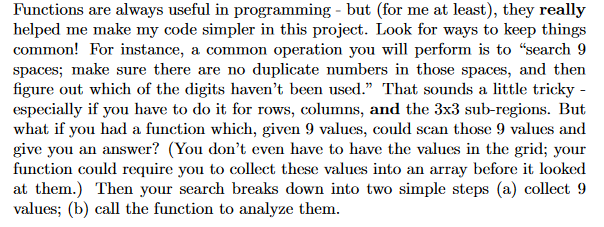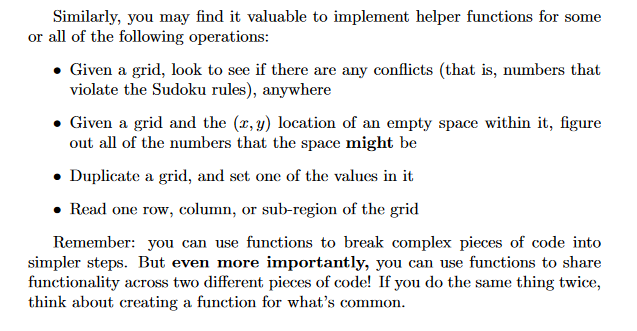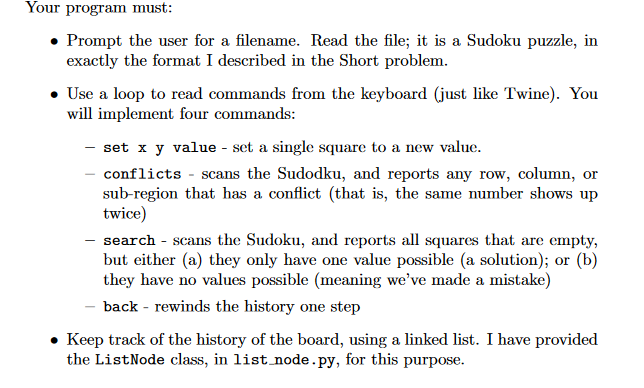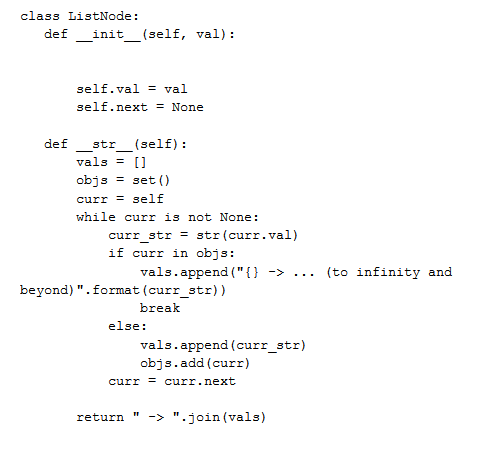





Functions are always useful in programming - but (for me at least), they really helped me make my code simpler in this project. Look for ways to keep things common! For instance, a common operation you will perform is to "search 9 spaces; make sure there are no duplicate numbers in those spaces, and then figure out which of the digits haven't been used. That sounds a little tricky - especially if you have to do it for rows, columns, and the 3x3 sub-regions. But what if you had a function which, given 9 values, could scan those 9 values and give you an answer? (You don't even have to have the values in the grid; your function could require you to collect these values into an array before it looked at them. Then your search breaks down into two simple steps (a) collect 9 values; (b) call the function to analyze them. Similarly, you may find it valuable to implement helper functions for some or all of the following operations: Given a grid, look to see if there are any conflicts (that is, numbers that violate the Sudoku rules), anywhere . Given a grid and the (z,y) location of an empty space within it, figure out all of the numbers that the space might be Duplicate a grid, and set one of the values in it Read one row, column, or sub-region of the grid Remember: you can use functions to break complex pieces of code into simpler steps. But even more importantly, you can use functions to share functionality across two different pieces of code! If you do the same thing twice, think about creating a function for what's common. Your program must: Prompt the user for a filename. Read the file; it is a Sudoku puzzle, in exactly the format I described in the Short problem. Use a loop to read commands from the keyboard (just like Twine). You will implement four commands: - set x y value - set a single square to a new value. conflicts - scans the Sudodku, and reports any row, column, or sub-region that has a conflict (that is, the same number shows up twice) search - scans the Sudoku, and reports all squares that are empty, but either (a) they only have one value possible (a solution); or (b) they have no values possible (meaning we've made a mistake) back - rewinds the history one step Keep track of the history of the board, using a linked list. I have provided the ListNode class, in list node.py, for this purpose. To figure out what the proper output is for each command, look at the output files from the testcases. One question you might have, however, is what order to search the board in the conflicts and search commands. For the conflicts command, search the columns, then the rows, then the sub-regions; when searching the sub-regions, search all of the sub-regions on the top, then the middle, then the bottom. A Likewise, in the search command, search the entire top row, then move down to the next row, and so on, through the entire board. 6 Using a Linked List as a Stack Sometimes, people implement a stack using an array; other times, they use linked lists. Both are good options, with different tradeoffs. For this project, you are required to use a linked list to implement the stack. To push a new value onto the stack, create a new ListNode object, and then make it the new head, pushing" it in front of whatever was there before. To pop a value off of the stack, you remove the head node, and make the second node the new head. (As with Twine, don't allow the user to pop off the last element from the stack.) Here's how it looks in a reference diagram. Let's start with a small stack (we're using integers here; your stack should contain Sudoku boards): head 30 20 10 When we insert a new value onto the stack, the new node becomes the head, and the old head becomes the next node: head 40 30 20 10 class ListNode: def _init__(self, val): self.val = val self.next = None def str (self): vals = [] objs = set() curr = self while curr is not None: curr_str = str (curr.val) if curr in objs: vals.append("{} -> ... beyond)". format (curr_str)) break else: vals.append(curr_str) objs.add(curr) curr = curr.next (to infinity and return IT -> ".join(vals) Functions are always useful in programming - but (for me at least), they really helped me make my code simpler in this project. Look for ways to keep things common! For instance, a common operation you will perform is to "search 9 spaces; make sure there are no duplicate numbers in those spaces, and then figure out which of the digits haven't been used. That sounds a little tricky - especially if you have to do it for rows, columns, and the 3x3 sub-regions. But what if you had a function which, given 9 values, could scan those 9 values and give you an answer? (You don't even have to have the values in the grid; your function could require you to collect these values into an array before it looked at them. Then your search breaks down into two simple steps (a) collect 9 values; (b) call the function to analyze them. Similarly, you may find it valuable to implement helper functions for some or all of the following operations: Given a grid, look to see if there are any conflicts (that is, numbers that violate the Sudoku rules), anywhere . Given a grid and the (z,y) location of an empty space within it, figure out all of the numbers that the space might be Duplicate a grid, and set one of the values in it Read one row, column, or sub-region of the grid Remember: you can use functions to break complex pieces of code into simpler steps. But even more importantly, you can use functions to share functionality across two different pieces of code! If you do the same thing twice, think about creating a function for what's common. Your program must: Prompt the user for a filename. Read the file; it is a Sudoku puzzle, in exactly the format I described in the Short problem. Use a loop to read commands from the keyboard (just like Twine). You will implement four commands: - set x y value - set a single square to a new value. conflicts - scans the Sudodku, and reports any row, column, or sub-region that has a conflict (that is, the same number shows up twice) search - scans the Sudoku, and reports all squares that are empty, but either (a) they only have one value possible (a solution); or (b) they have no values possible (meaning we've made a mistake) back - rewinds the history one step Keep track of the history of the board, using a linked list. I have provided the ListNode class, in list node.py, for this purpose. To figure out what the proper output is for each command, look at the output files from the testcases. One question you might have, however, is what order to search the board in the conflicts and search commands. For the conflicts command, search the columns, then the rows, then the sub-regions; when searching the sub-regions, search all of the sub-regions on the top, then the middle, then the bottom. A Likewise, in the search command, search the entire top row, then move down to the next row, and so on, through the entire board. 6 Using a Linked List as a Stack Sometimes, people implement a stack using an array; other times, they use linked lists. Both are good options, with different tradeoffs. For this project, you are required to use a linked list to implement the stack. To push a new value onto the stack, create a new ListNode object, and then make it the new head, pushing" it in front of whatever was there before. To pop a value off of the stack, you remove the head node, and make the second node the new head. (As with Twine, don't allow the user to pop off the last element from the stack.) Here's how it looks in a reference diagram. Let's start with a small stack (we're using integers here; your stack should contain Sudoku boards): head 30 20 10 When we insert a new value onto the stack, the new node becomes the head, and the old head becomes the next node: head 40 30 20 10 class ListNode: def _init__(self, val): self.val = val self.next = None def str (self): vals = [] objs = set() curr = self while curr is not None: curr_str = str (curr.val) if curr in objs: vals.append("{} -> ... beyond)". format (curr_str)) break else: vals.append(curr_str) objs.add(curr) curr = curr.next (to infinity and return IT -> ".join(vals)












